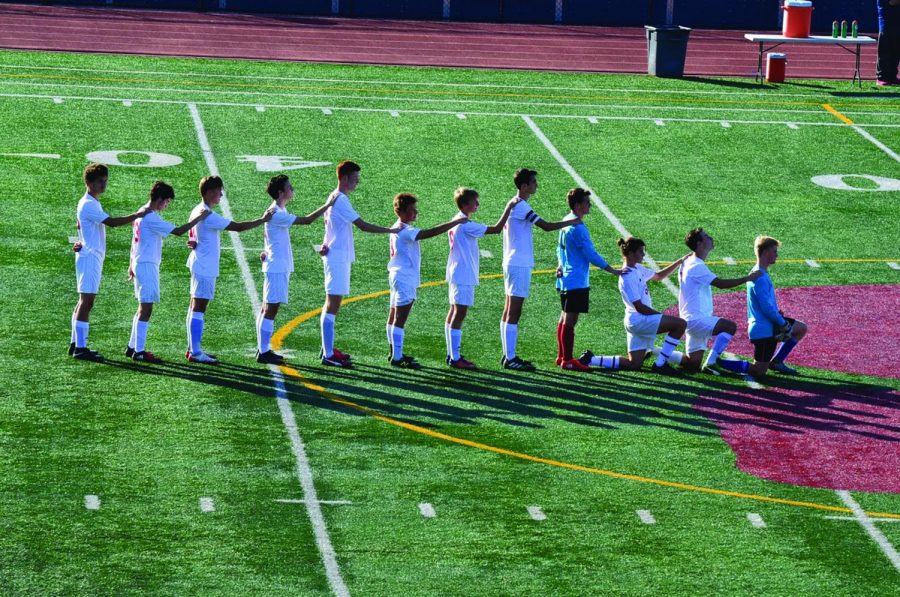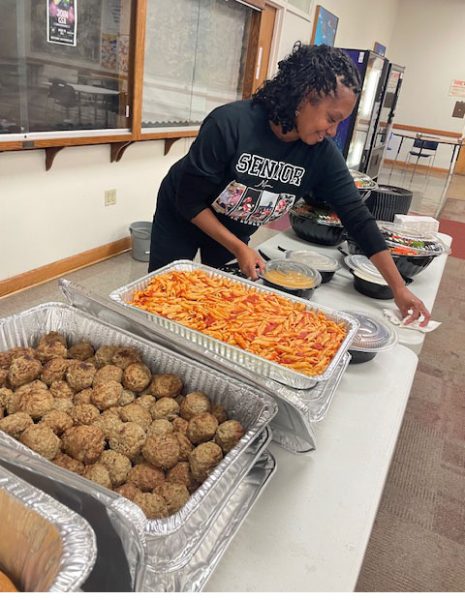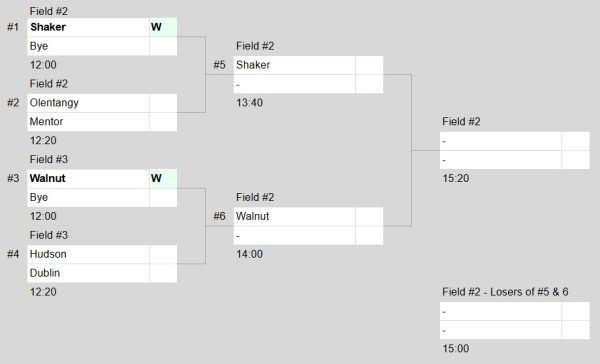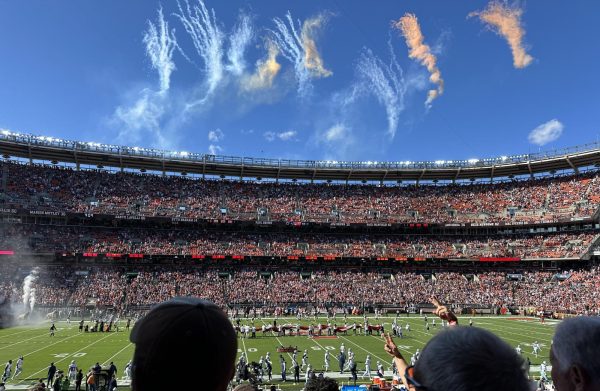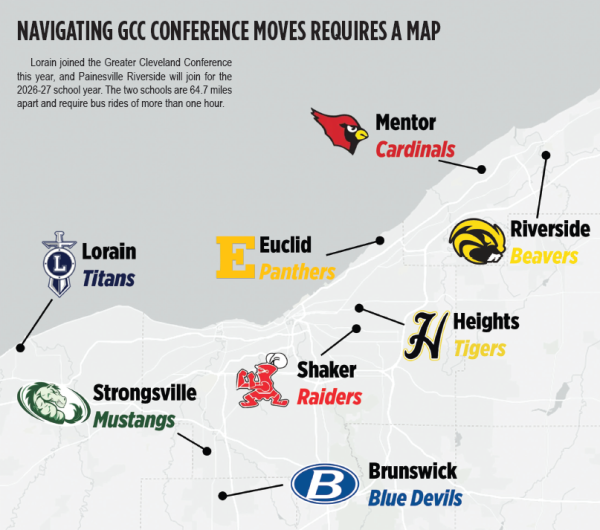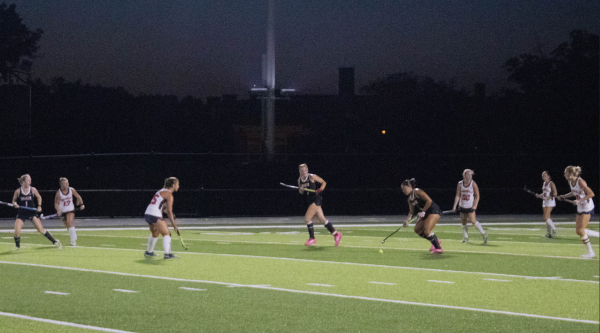Taking a Knee and Action
Shaker embraces protest and challenges athletes to create change
Shaker Heights High School has embraced national anthem protests. There hasn’t been major backlash from students, staff or administrators. Kneeling during the anthem is a divisive issue, yet there has been acceptance and respect for the protests.
Ex-San Francisco 49ers quarterback Colin Kaepernick entered the spotlight Aug. 26, 2016 after images surfaced of him kneeling during the national anthem to protest police shootings of unarmed African-American males. It wasn’t the first time Kaepernick knelt during the anthem, but these images kickstarted his movement.
Two days later, Kaepernick addressed the media to justify his protest.
“I’m going to continue to stand with the people that are being oppressed. People are dying in vain because this country isn’t holding their end of the bargain up, as far as giving freedom and justice, liberty to everybody,” Kaepernick said.
“When there’s significant change, and I feel that flag represents what it’s supposed to represent, and this country is representing people the way that it’s supposed to, I’ll stand,” he continued.
It’s been over a year since Kaepernick’s movement began, and its popularity and influence hasn’t faded. Athletes at the high school, collegiate and professional levels have joined the protest.
The national anthem, or “The Star Spangled Banner,” is the first stanza of a 1814 poem written by Francis Scott Key. According to the Smithsonian National Museum of American History, the anthem was meant to be a patriotic song, inspired by the Battle of Baltimore in the War of 1812. Because it describes the battle, some consider it a song honoring the military.
Playing the anthem before sporting events became a tradition in 1918 during the seventh inning of game one of the World Series between the Boston Red Sox and Chicago Cubs. In the midst of World War I, the crowd embraced the display of patriotism, and the “Star Spangled Banner” was subsequently played during the seventh inning of World Series games.
During the World War II era, the addition of sound systems allowed major league baseball and football stadiums to play the anthem before every game.
For six of Shaker’s 11 fall sports, including football and fall sideline cheerleading, women’s and men’s soccer, field hockey and volleyball, the anthem is played before events. However, the anthem is not played before the remaining five fall sports, including men’s and women’s golf, women’s tennis and men’s and women’s cross country.
Athletic Director Don Readance explained that because these sports do not take place in a stadium, there is no speaker available to play the anthem.
There are no Ohio High School Athletic Association guidelines for the playing of the national anthem before sporting events, so it is at the school’s discretion whether or not to do so.
After World War II ended, former NFL Commissioner Elmer Layden said, “The national anthem should be as much a part of every game as the kickoff. We must not drop it simply because the war is over. We should never forget what it stands for.”
Senior Chris Richardson said that, to him, the anthem “represents all the hard work people have put in to make this country as great as it is today.”
To junior crew rower Sophie Calabrese, the anthem symbolizes “the American Dream and the ideal America. It represents an ideal that we should work toward.”
Junior swimmer Kaitlyn Smith said the “Star Spangled Banner” doesn’t represent anything to her. “I don’t think a lot of people know what it means,” Smith said.
Senior Cash Thomas said the song embodies racism, slavery and discrimination.
He continued that there needs to be a new national anthem that “better represents America and its people … Something that people can stand behind and believe in. A land that can protect its citizens and give them what they need on their path to life, liberty and happiness.”
Legally, high school athletes can choose whether or not to stand for the national anthem, and school officials have no right to mandate participation.
“By banning or discouraging students from participating in protests against racial discrimination, police brutality and other important issues, schools not only violate their First Amendment rights but deny them the opportunity to join a national debate that can contribute to their civic education,” The National Coalition Against Censorship stated on their website.
After public school officials attempted to punish Jehovah’s Witnesses who didn’t recite the Pledge of Allegiance, the Supreme Court ruled in West Virginia State Board of Education v. Barnette, 1943, that high school athletes aren’t required to salute the flag.
In its Barnette ruling, The Supreme Court stated, “The action of a State in making it compulsory for children in the public schools to salute the flag and pledge allegiance… violates the First and Fourteenth Amendments.”
“To believe that patriotism will not flourish if patriotic ceremonies are voluntary and spontaneous instead of a compulsory routine is to make an unflattering estimate of the appeal of our institutions to free minds,” former Justice Robert Jackson wrote.
Although the Shaker community is known for its liberal viewpoints, some Shaker athletes believe there is a risk of receiving backlash due to this protest.
“It’s scary to do something [that] can be judged easily, although I believe Shaker is a relatively understanding community — an educated community,” sophomore field hockey player Anna Downing said.
Senior field hockey player Felecia Hamilton knelt on Oct. 10, the last home game of the year against Hathaway Brown.
“Both of my coaches and the whole team respected my decision to kneel along with other girls on the team. [My coach] made it clear that if anyone from the other team were to disrespect me for kneeling, she would have no tolerance for it,” Hamilton said.
Yet, she said, “I was worried about how my team and coaches would react—especially being one of only two black girls on the field hockey team.”
Hamilton explained that she knelt to support Kaepernick’s protest against police brutality and racial injustice.
“Right before the home game against HB, I had seen yet another video on Twitter of a policeman on top of a black teenager, punching his face repeatedly while people around him, including other officers, had to force him to stop,” she said.
“Just as the flag can symbolize those who have fought for our country, it can also symbolize the racial injustice that is still too familiar for black lives in America,” she said.
Hamilton also said that because it is custom to take a knee for injured players, it makes sense to take a knee for all the victims of police brutality and racial discrimination.
“Too many black lives are lost to police brutality in America and, just like on the field when a player is injured, everyone else on the field takes a knee. I am taking a knee for Tamir Rice, Michael Brown, Philando Castile and so many more who have fallen at the hands of those who are supposed to protect us,” Hamilton said.
Unlike the field hockey team, Shaker’s football team remains inside their locker room while the marching band plays the anthem.
Readance said, “Almost everybody in our conference does this as well. That’s just the way the schedule is and always has been.”
However, Brunswick High School plays the national anthem while the football team stands on the sidelines.
At a Sept. 8 varsity football away game against Brunswick, senior wide receiver Micah Hills, senior linebacker Sam Meinhard and senior quarterback Jamir Dismukes sat during the national anthem.
“Why should I stand to support a country that preaches equal rights but doesn’t stand by them?” Hills asked.
Head Football Coach Jarvis Gibson declined to comment.
As an alternative to this divisive form of protest, football teams have begun locking arms rather than kneeling to promote unity.
NFL teams such as the Cleveland Browns and the Dallas Cowboys, have locked arms during the anthem.
“It’s better to lock arms to show that we are a unit and show that we care what others think about us. So, some of us stand, some of us kneel, but after all, [we’re] all brothers,” freshman football player Danny McCall said.
Shaker Heights Marching Band Director Jason Clemens addressed the marching band Sept. 28 to suggest appropriate protesting methods after band members asked him to refrain from playing the anthem.
Clemens declined to comment.
Senior percussion player Nate Cowan said, “Kids were coming to [Clemens] asking if they could [kneel] and wanting to [kneel], so he just wanted to let everyone know that he wouldn’t be upset.”
Senior tuba player David Mack said, “There would be no consequences or any backlash if you decided to show your opposition to what’s happening. He respects everybody’s decision because it’s their First Amendment right.”
Kuehnle, however, said band members should not object to playing the national anthem.
“If you’re in the band … you’re going to be playing the anthem before games; that’s what you’re signing up for. I think we’ve reached a pretty good arrangement with our Raiderettes and band where Raiderettes can take a knee, and band members can take a knee and keep playing,” he said.
Kuehnle also discussed what else students can do to further their cause besides kneeling. “We’re encouraging them to think about different service projects and activities that bring people together,” he said.
Senior Wilder Geier, a soccer player who has knelt during the anthem, said he’s talked to Ose Arheghan, leader of the high school’s NAACP chapter, about further action that his team can take.
“I talked to Ose about what I can do, and we are still trying to figure out something the soccer team can do because that’s the context in which I knelt,” Geier said.
Assistant Principal Ramsey Inman said, “Any type of peaceful protest is effective. But if you want to change people’s mind, then there has to be conversation and discussion or action after that. I challenge the people who kneel or sit to go out and make a change as well.”
Kuenle said the only reason the school would tell a student not to take a knee would be if there was a direct safety concern.
“The coaches, the athletic director and the principal have said that they want us to talk to them beforehand as primarily a safety concern, which I don’t see as a big issue,” Geier said.
Geier has knelt at away games at Mentor and Medina, districts where Geier feels Shaker is sensitive to the possibility of backlash to protest.
Geier said, “They are whiter areas that Shaker would consider not as open to the protest.”
However, Geier said there was no backlash from the crowds.
“Actually, the Medina coach commended me,” he added.
Inman also does not see a safety concern with kneeling.
“I am not concerned with student safety. Since I’ve arrived at Shaker, I’ve seen that students are very vocal with issues, but they also seem to respect others’ rights and liberties. And the community has always been supportive of their right to protest,” he said.
English teacher Jody Podl constructed a lesson to discuss anthem protests for her Advanced Placement Composition class. She focused the discussion on the complexity of the issue and encouraged students to consider different viewpoints.
“Students in our class really came out of it feeling like they’ve learned a lot. I think that people really understand that you have to find out what people are saying and really investigate sources and make sense of things,” she said.
Podl also mentioned that while discussing the anthem protests can be difficult, doing so is crucial to resolving conflict.
“I think that even if discussion is uncomfortable, that might be more of a reason to have it because I think that that’s where we all have to grow and be willing to look at things that are uncomfortable,” she said.
Kuehnle said, “I’ve been inspired by the student athletes who have chosen to do this. They’re not doing it just because it’s in the news, or it’s a trend or it’s cool and rebellious. The ones who are motivated to engage in this form of protest are doing it because they genuinely feel that it is something that needs more attention paid to it.”

